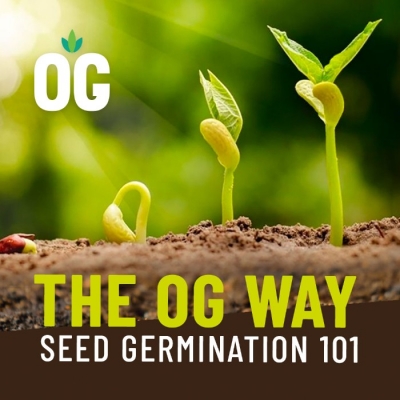1. Choose the Perfect Strain
Preparation is key. Great genetics provide the blueprint for a thriving cannabis grow and play a major role in the quality, quantity, and characteristics of the final flowers. You’ll want to choose the right strain to fit your indoor grow space but also, crucially, find one that produces buds with the flavour profile and effects which you prefer. We truly have something for everyone. Visit our strain catalogue and use the filters on the left to navigate your way to finding your ideal genetics – shop for seeds now!
2. Pick Your Growing Medium
The right cannabis soil is essential! It needs to be the right mix of aerated and moist, which is why weed plants thrive in coco coir (with a bit of know-how), but we recommend going with premixed soil to keep it simple. Fortunately, you can easily find marijuana soil mixes online or at local nurseries or grow shops in South Africa. Of course, you’ll need pots to put it in and trays to catch any excess water.
3. Know Your Nutrients
It’s all about NPK – that’s nitrogen, phosphorous, and potassium – in the right amounts, at the right time. You can add all sorts of nutes and soil amendments to help your babies thrive or keep it simple. Luckily, you can quite easily find good-quality, organic nutrient mixes for both the veg (often labelled “grow”) and flowering (“bloom”) stages of the marijuana plant’s life cycle in SA. We recommend buying nutrients that come with a cannabis feeding chart (which you might find online) and leaning towards a lighter hand than what’s suggested.
4. Get the Right Grow Light
This is often a case of different strokes for different home grower folks – some OGs swear by using HIDs (metal halide and high-pressure sodium lights), even different types at different times. CFLs (compact fluorescent lights) work well for seedlings – which is also a good tip for outdoor growers looking to get a head start on the season by germinating cannabis seeds indoors. It’s a personal choice that might come down to finances, especially in South Africa where we have Eskom’s prices and load shedding to content with. Our advice? Save on electricity at all costs – it’s a no-brainer! Go with an LED and do your homework in terms of bang for your buck.
5. Install Suitable Fans
You’ll definitely want to run an oscillating fan to strengthen the marijuana plants’ stems as they grow, while also preventing mold and bud rot and keeping pests like fungus gnats and mites at bay. An extractor fan is always a good idea too, if at all possible, depending on your setup. This will help to pull stale, hot air out while allowing fresh air through your air inlet – very necessary when running large or hot lights.
6. Create a Thriving Environment
There’s a lot to this step so do your homework. Make sure your environment is right for each growth stage. Mimic natural day and night cycles as well as the seasons during which marijuana thrives to maximize your yield. Spray seedlings with water while establishing root systems and avoid strong winds. Stick to a light cycle of 18/6 and 12/12 light/dark during veg and flowering, respectively. Turn the oscillating fan off at night. Research, measure, and chart ideal temperature and humidity during lights on/off during the different growth stages. Depending on your environment and season, you may even want to consider a dehumidifier to help prevent mildew.
7. Water & Feed Optimally
Don’t overwater or underwater your weed plants. Too little water stunts growth and too much rots roots. It’s all about finding that “Goldilocks zone” – just the right amount. You should water them thoroughly (good cannabis soil still allows root aeration), allowing the top 3-4cm of soil to dry before watering well again. The same applies to your nutes. Plants often need less than what’s recommended on the manufacturer’s label. You’ll need to find the optimal watering and feeding schedule for your unique setup.
8. Train & Prune Plants
Some OGs like to purchase indica-dominant cannabis seeds and let their indoor plants grow “au naturel”. But with a bit of expertise or research, you can train your plants to maximize yields. We definitely recommend topping at least once and using stakes or ties to provide structural support. Stretchy sativas work well with a SCROG (screen of green) net, if you have time for some extra TLC. One absolute necessity is pruning away excess leaves to allow aeration and light penetration – this will help you to avoid the demon that is powdery mildew.
9. Know When to Harvest
After all the effort you’ve put into nurturing your babies, knowing when you harvest them is vital to the quality and potency of the final product. As marijuana plants mature during flowering, you’ll notice more and more leaves turning yellow and dying off, pistils (hairs) darkening, and gorgeously gooey, cannabinoid-rich trichomes turning from clear to cloudy-white and then amber. A jeweller’s loupe is a handy tool here. A good rule of thumb is to start harvesting when about 10-30% of trichomes on your flowers have turned amber. If you’re a one-man or one-woman team with a lot to get through, you may want to start your harvest a couple of days early.
10. Dry & Cure Correctly
Hang your beautiful buds in a dark room at about 50% humidity with good air circulation for around 10-12 days – a dehumidifier can come in handy here and speed up drying time. When buds “snap” off the stalks, it’s time to fill your glass jars to about three-quarters full and close them up tightly. Burp the jars daily in dry air for up to half an hour, allowing all the moisture to escape. Be sure to stick your nose deep in there as you open each jar up. You’ll notice beautiful aromas coming through and intensifying for 4-8 weeks, at which time your flowers should be properly dried and cured.
We know we don’t have to add an eleventh step telling you to enjoy! Get your seeds now.
P.S. There’s no limit to the number of weed seeds you’re allowed to have at home, but don’t forget to stick to the legal limits for growing cannabis in South Africa.




